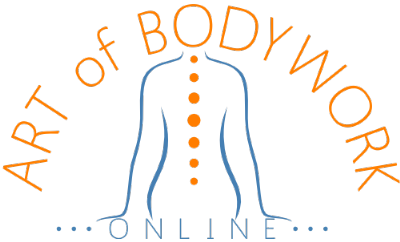BREAST
Please scroll to the bottom of the page to enable translation for the entire text. | |
Then click the printer symbol to print the instructions in your chosen language. | |
Please note this is an automatic translation, which means there may be some errors. |

Copyright © Alastair McLoughlin 2015 Revised © Alastair McLoughlin 2019 and 2022
The right of Alastair McLoughlin to be identified as the original Designer, Developer and Author of the Work has been asserted by him in accordance with the Copyright, Design and Patents Act 1998.
All rights reserved. No part of this text may be reproduced, stored in a retrieval system, or transmitted in any form or by any means without the prior written permission of the publisher, nor be otherwise circulated in any form of binding or cover, or reprinted in any physical or electronic manner without the written consent of the author.
The ideas and concepts explored within this text are those of the author. For educational purposes only.
No diagnosis is being offered nor any cure promised by the application of this information.
Alastair McLoughlin cannot be held responsible for any injury arising from the application of this work by the practitioner to any third party however caused.
This work is not a substitute for medical attention. Please seek your physician’s advice if in doubt.
Keeping the cells of the breast well oxygenated and nourished, through increased blood flow and drained of harmful debris via the lymphatic system, will ensure the best possible environment for breast health and reduce the likelihood of the development of more serious health issues and future complications.
Therefore, this work is potentially life-changing for some women. There are two applications to the tutorial:
- For specific sore or painful areas of the breast
- As part of ongoing, regular breast health care treatment
This most delicate of work produces amazingly effective reductions in pain and tenderness with incredible lymph drainage effects.
The results can be dramatic as pain and soreness can disappear within moments of the application.
You can also adapt this work for self-treatment.
See the instructional video presentation for clarification and exact finger placement which is critical in this instance.
 INDICATIONS FOR USE
INDICATIONS FOR USE- Pain, soreness or tenderness of the breast due to hormonal fluctuations
- Breast cysts
- Fibrous, hard or lumpy breasts
- Breast congestion
 CAUTIONS OR CONTRAINDICATIONS
CAUTIONS OR CONTRAINDICATIONS If you have ANY doubts about WHAT you are treating have your client medically checked out before using this work.
If there are unknown masses or possible infection - have it checked first.
If there are any visual abnormalities (puckering, dimpling, depressions for example) have them medically checked out.
When the doctor gives the all clear that no serious underlying problems have been found then you are clear to use this AoB technique for your client - or yourself.
We begin from a starting point that confirms all potential problems have been checked for medical complications or cancer and that treating the breast poses no medical contraindication or presents any danger to the patient.
Do not proceed if you are unsure about any undiagnosed symptoms!
 Position of the patient:
Position of the patient:The patient should lay supine on the treatment table. The arm may need to be raised above the head to access certain areas of the breast or axilla.
SPECIAL NOTE:
ALL work must be performed using the PADS of the fingers - NOT the fingertips as this is too painful and invasive for the client.
ALSO:
There is a specific direction in which to apply the AoB movements - which is dependent upon the location of the area of pain or discomfort that is being addressed. Refer to the illustrations below to determine in which direction you need to make the AoB move/s.
 The move:
The move:The technique we use is to “anchor” the tissue adjacent to the painful or sore area. (i)
We position the index finger of the opposing hand upon the breast tissue (ii) - leaving a gap where the tender tissue is located.
We then “glide” along in the direction shown (iii) - Remember the direction of the intended move (or “drag”) is dependent upon exactly where the sore or painful area is located.
The “glide” is performed with intention and purpose - it is not just sliding on the skin.
After a couple of these “anchor” and “drag” applications you can work more upon the tender area - which should now be less tender.
Once a reduction in tenderness is achieved the tips of the index fingers can now be in contact at the beginning of the AoB move (iv).
 Application for when there are sore, tender or painful specific areas of the breast:
Application for when there are sore, tender or painful specific areas of the breast:Important:
Ask the client to palpate their own breasts and indicate to you where the problem areas seem to be.
Make a careful record of the exact location of each painful point.
Locate one painful area that you intend to work upon and implement parts i, ii, iii and iv of ‘The Move’ - see previous section.
Remember the direction of the intended move (or “drag”) is dependent upon exactly where the sore or painful area is located.
For examples - see illustrations below.
 = painful area
= painful area = direction of move
= direction of moveTreatment application times depend on tissue responses.
You probably do not need to work for more than 1 minute for any specific point of pain or tenderness.
Lumpy and fibrous tissue may need regular, weekly (but not prolonged) treatments for the tissue to become soft and comfortable.

Treatment pressure is light and gentle - within the tolerance of your client.
Softening of fibrous, lumpy breasts can be achieved with regular sessions.
Swelling or oedema can reduce from the first application of this AoB work.
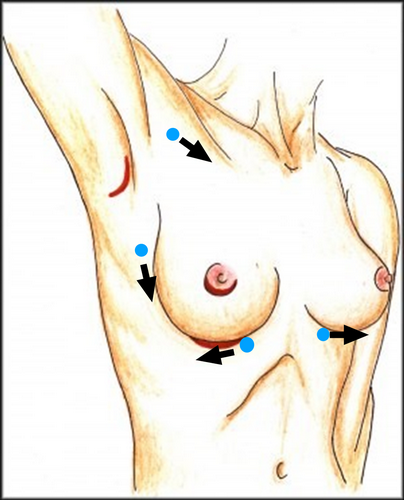
These examples (above) give the direction of moves for specific painful areas.
Check with the client during treatment to ensure no discomfort is being experienced and if tissue pain and soreness is diminishing.
Apply the AoB movements as shown in the video presentation.
 Application for ongoing, regular breast care:
Application for ongoing, regular breast care:The following illustrations show the direction of the moves for any specific part of the breast.
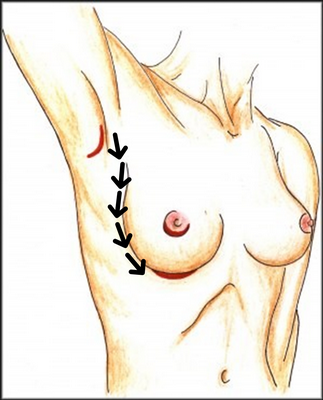
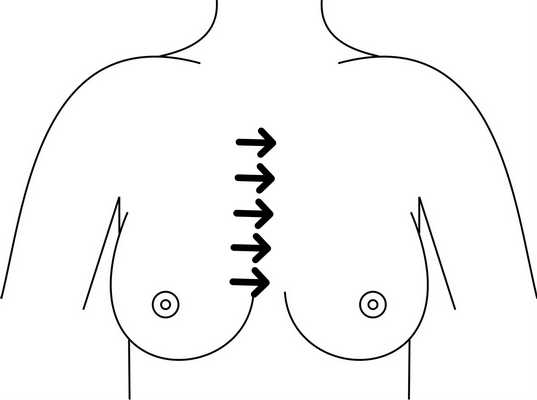
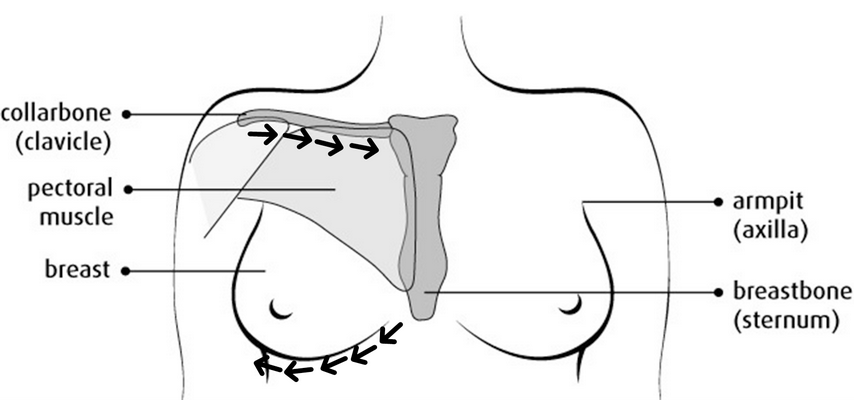
This sequence can form part of your client’s regular breast care work.
SEQUENCE A:
Imagine a clock face, with the nipple being in the centre of the clock.
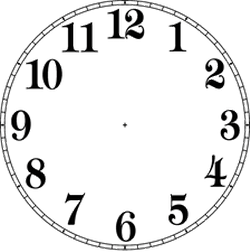
Make a series of AoB moves as shown from the nipple, radiating outwards around the clock face - 1, 2, 3, etc - as shown in the video presentation.

SEQUENCE B:
Make a series of AoB moves - beginning at the axilla and descending down the lateral part of the breast/chest wall.

SEQUENCE C:
Make a series of AoB moves - from the edge of the breast tissue medially towards the sternum.

SEQUENCE D:
Make a series of medial AoB moves from just inferior of the clavicle towards the sternoclavicular joint.

SEQUENCE E:
Make a series of lateral AoB movements commencing towards the midline of the body, adjacent to the sternum, and following the contour of the underside of the breast.
If the breasts are heavy or pendulous then your client can support the weight of the breast tissue to enable easy access to the underside of the breast for the practitioner.
Treatment time is approximately 12-15 minutes for each breast as part of a weekly or monthly regime.
Treatment pressure is light to moderate (1 to 4 or 5 out of 10) - and well within the tolerance of your client.
NOTE:
Scar tissue from previous surgeries may need additional specialised work. To learn scar tissue treatment, see our additional online (or in-class) training at:
https://www.mcloughlin-scar-release.com
 BONUS MATERIAL:
BONUS MATERIAL:Application 1: Sinus congestion
Follow the directions as shown for helping clear sinus congestion. Easy to apply work in the clinic or even for your own needs. Brings very good relief from stuffiness.
Application 2: Lymph congestion of the lower leg
You may apply this technique in other congested areas too - such as the upper or lower arm.
Take care when applying this work for lower leg - ensuring these are no contraindications such as DVT (Deep Vein Thrombosis).
Apply the technique through the central division of the gastrocnemius as shown. May also be applied around swollen ankles.
Take care with your pressure and always work within the tolerance of your client.
Application 3: Fascial restrictions - “stickiness”
The is extremely effective at releasing “stuck” fascial layers.
For example, the division between the Vastus Lateralis and Ilio-Tibial Band - or Vastus Medialis and Rectus Femoris.
The work creates clearer divisions within the muscle group which encourages better lymph draining and gliding of tissues.
Especially good for athletes and those involved in physical activities.
Use it as part of regular “tune up” programme - before and after competition.
Also has great value for the spastic or immobile patient.
Use regularly as their muscles and soft tissues can become very ‘stuck’.
Apply the work following the divisions in the muscle group.
These may be difficult to find at first.
The division between ITB and Vastus Lateralis can be difficult to find on some people, but the delineation becomes clearer as you continue to work.
 How it works:
How it works:You may ask - Why is this work different? Wouldn’t a good massage be just as effective?
Those are good questions and, as a masseur of nearly 40 years, I can say that this technique of “anchor” and “glide” is very tissue specific.
It therefore targets the tissue very precisely - but in a structured and logical way.
The “glide” is performed with intention and purpose - it is not just sliding on the skin. In the process it stimulates lymphatic drainage and produces a very specific change in lymph flow.
Breasts can become softer and more supple within moments of this first application moves.
Some clients feel the tissues release as you’re performing the work - as if it is being “pulled apart” - but not in an aggressive or unpleasant manner.
Due to its specificity, tissue responses are usually extremely quick.
This helps reduce the opportunity for tissue irritation and an inflammatory reaction to occur - which is worthy of some consideration when dealing with blocked lymph and its effect on the tissues we are treating.
This naturally reduces treatment times significantly and enables the healing process more effectively.
FAQ’s
Q: Can I use this work with someone with breast implants?
A: This work is used specifically for problems associated with breast tissue - not non-organic breast implants.
You may use it for tissue problems around the implant - such as in the sub-clavicular region, but not over breast implants.
If there are problems with breast implants, then refer your client back to their surgeon.
Q: Will I have to keep repeating this work for sore and tender breasts?
A: Due to hormonal changes this may be necessary from month to month.
However, I have found that fibrous, lumpy breasts tend not to need much repeated treatment once you have achieved a soft and supple feel to the breast.
The positive effects of this technique continue for some time, but please encourage the client to return as often as needed should the breasts start to become fibrous and hard once again.
This work is a wonderful way to maintain soft and comfortable breasts.
Q: Can I use this work for a nursing mother with breast milk production issues?
A: In all honesty I have not used it in this capacity.
However, if you are asked for help with milk production problems by post-natal women it may be of benefit.
For example, if there are problems with breast engorgement, the lymph drainage effect may be of huge benefit.
Conversely lack of milk may be helped be reversing the direction of the moves on the breast.
Instead of moves away from the nipple, make the AoB moves towards the nipple to aid the flow of milk through the milk ducts.
Q: Are there any ethical issues involved using this work?
A: Much depends on culture and attitudes to the touching the breast - even in a therapeutic capacity.
If you or your client need reassurance, have a 3rd party present in your treatment room when using this work.
If a woman does not want to show her breasts this work may be performed quite effectively through light clothing.
Additionally, there may be certain rules governing the touching of the breast by various massage associations, insurance companies and even state/country laws.
Please make yourself aware of any legislation or rules governing the treatment of breasts that your association, insurance or state and country laws have in place.
Any other questions?
Email me at: office@artofbodywork.online
